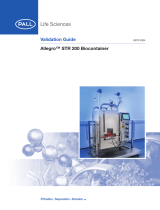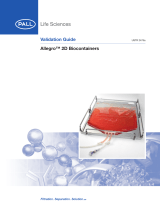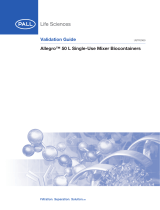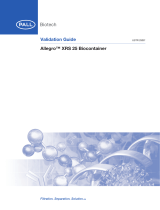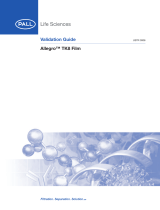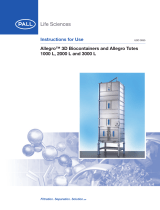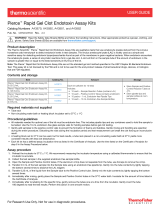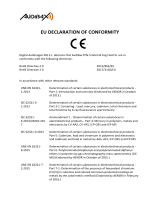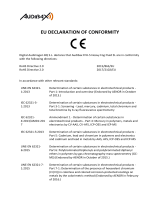Page is loading ...

Validation Guide
Allegro™ 3D Biocontainers and Totes
USTR 2527b

Contents
1. Validation Overview ...........................................................................................................4
1.1 Introduction ..................................................................................................................4
1.2 Summary of Conclusions ..............................................................................................4
1.2.1 Filling, Drainage, Transport, and Stacking Tests ....................................................4
1.2.2 Water Leak Test....................................................................................................5
1.2.3 Resistance to Gamma Sterilization ......................................................................5
1.2.4 Connections Testing ............................................................................................5
1.2.5 Shelf Life Studies..................................................................................................5
1.2.6 Extractables Study................................................................................................5
1.2.7 Biological Safety Tests ..........................................................................................5
1.2.8 Physico-chemical Tests ........................................................................................6
2. Filling, Drainage, Transport, and Stacking Tests..............................................................6
2.1 Introduction ..................................................................................................................6
2.2 Summary of Methods ....................................................................................................6
2.2.1 Filling Test ............................................................................................................6
2.2.2 Drainage Test........................................................................................................6
2.2.3 Transport Test ......................................................................................................6
2.2.4 Stacking Test........................................................................................................6
2.3 Results ..........................................................................................................................7
2.3.1 Filling Test ............................................................................................................7
2.3.2 Drainage Test........................................................................................................7
2.3.3 Transport Test ......................................................................................................7
2.3.4 Stacking Test........................................................................................................7
2.4 Conclusions ..................................................................................................................7
3. Water Leak Testing ............................................................................................................7
3.1 Introduction ..................................................................................................................7
3.2 Summary of Methods ....................................................................................................7
3.3 Results ..........................................................................................................................8
3.4 Conclusion ....................................................................................................................8
4. Resistance to Gamma Irradiation of the PolymerFilm....................................................8
4.1 Introduction ..................................................................................................................8
4.2 Summary of Methods ....................................................................................................8
4.3 Results ..........................................................................................................................8
4.4 Conclusions ..................................................................................................................9
5. Connection Testing ............................................................................................................9
5.1 Introduction ..................................................................................................................9
5.2 Summary of Methods ....................................................................................................9
5.2.1 Strength Test ........................................................................................................9
5.2.2 Leak Test..............................................................................................................9
5.3 Results ........................................................................................................................10
5.4 Conclusion ..................................................................................................................10
2

3www.pall.com/biopharm
6. Shelf Life Studies .............................................................................................................10
6.1 Introduction ................................................................................................................10
6.2 Summary of Methods ..................................................................................................11
6.2.1 Leak Test............................................................................................................11
6.2.2 Tensile Strength Test ..........................................................................................11
6.2.3 Peel Test ............................................................................................................12
6.3 Results ........................................................................................................................12
6.3.1 Twelve (12) and 36 Month Accelerated Shelf-life Tests........................................12
6.4 Conclusions ................................................................................................................12
7. Extractables Study...........................................................................................................13
7.1 Introduction ................................................................................................................13
7.2 Summary of Methods ..................................................................................................13
Allegro Biocontainer Filling and Recording of Weight (Empty and Filled) ......................14
pH Measurement ........................................................................................................14
Conductivity ................................................................................................................14
Total Organic Carbon (TOC) ........................................................................................14
Metal (ICP-OES) ..........................................................................................................14
Ion Chromatography....................................................................................................14
Volatile Organic Compounds by Headspace-GC/MS ..................................................14
Solvent Extraction along with GC/MS ..........................................................................14
Solvent Extraction along with LC/MS ..........................................................................14
Derivatization GC/MS ..................................................................................................14
7.3 Results ........................................................................................................................15
7.4 Conclusions ................................................................................................................15
8. Biological Tests ................................................................................................................16
8.1 Introduction ................................................................................................................16
8.2 Summary of Methods ..................................................................................................16
8.2.1 USP <88> Biological Reactivity Test, In Vivo, for Class VI-50 °C Plastics ..........16
8.2.2 USP <87> Biological Reactivity Tests, In Vitro....................................................17
8.2.3 ISO 10993 Biological Evaluation of Medical Devices ..........................................17
8.2.4 USP <85> Bacterial Endotoxins (European Pharmacopoeia 2.6.14) ..................18
8.3 Endotoxins Determination Tests ..................................................................................18
8.4 Results ........................................................................................................................18
8.5 Conclusions ................................................................................................................18
9. Physical/Physico-chemical Tests....................................................................................18
9.1 Introduction ................................................................................................................18
9.2 Summary of Methods ..................................................................................................18
9.2.1 USP <661> Containers - Plastic ........................................................................18
9.2.2 European Pharmacopoeia (3.1.5)........................................................................19
9.2.3 Japanese Pharmacopoeia (Section 61 Part 1) ....................................................19
9.2.4 USP<788> Particulates in Injectables, Microscopic Particle Count Test..............19
9.3 Results ........................................................................................................................20
9.3.1 USP <661>, European, and Japanese Pharmacopoeia......................................20
9.3.2 Particles Testing..................................................................................................20
9.4 Conclusions ................................................................................................................21
10. Operation and Storage ..................................................................................................21

4
1. Validation Overview
1.1 Introduction
This guide contains data applicable to Allegro™ 3D biocontainers and totes. These high
quality flexible biocontainers are designed to be able to replace stainless steel tanks and
carboys in process applications, to reduce the risk of cross contamination and eliminate
cleaning and cleaning validation. The purpose of this report is to document testing that has
been performed to demonstrate the suitability of Allegro 3D biocontainers fitted in an
Allegro tote for use in biotechnology and pharmaceutical applications.
The Allegro biocontianer film is made of a low density polyethylene (LDPE) film that meets
the rigorous quality requirements of the biotechnology and pharmaceutical industry.
The Allegro biocontainer includes unique design features that significantly improve the
ease of use and robustness of single-use systems while enabling high product recovery.
The ports of Allegro 3D biocontainers have been configured so that maximum choice is
offered for inlet and outlet connections. There are two inlet ports: one out of the two inlet
ports can be used either for the introduction of sensor or as an additional filling line. Both the
inlet ports and the outlet ports can be connected to tubing of 3⁄8in., ½ in., ¾ in. and 1 in.
nominal inner diameter. A ¼ in. sampling port is available for all options which could be kept
open or closed depending on the specific application.
This validation guide summarizes the tests that were performed to qualify the performance
of Allegro 3D biocontainers in the appropriate Allegro tote for various applications.
1.2 Summary of Conclusions
1.2.1 Filling, Drainage, Transport, and Stacking Tests
Filling Test
In the filling test, the Allegro 3D biocontainer was securely placed in an appropriate
size Allegro tote and was filled to its capacity with water. During the filling process,
biocontainer expansions and any potential signs of deflections to the tote surface
or the biocontainer film were observed. The biocontainers were filled up to the
desired fill volume and observed deflections were as expected.
Drainage Test
In the drainage test, the liquid was allowed to drain via action of gravity and
the minimum hold-up volume within the Allegro biocontainer was measured.
During drainage, the biocontainer collapsed evenly. The minimum hold-up volume
after drainage was approximately 100 mL for the 100, 200 and 500 L biocontainers.
The hold-up volume after drainage for the 1000 and 1500 L Allegro biocontainers
was < 4 L.
Transport Test
In the transport test, a filled Allegro 3D biocontainer placed in appropriate size
Allegro tote was safely transported using an Allegro trolley for the 100, 200 and
500 L biocontainers and casters for the 1000 and 1500 L attached to the metal
tote over a distance of 100 meters.
Stacking Test
In the stacking test, the maximum stack height of three (3) 100/200 L Allegro totes
were safely stacked on top of each other and remained stable. In addition, the
maximum stack height of two (2) 500, 1000 and 1500 L Allegro totes were stacked
on top of each other and also remained stable during filling and emptying of the
appropriate Allegro 3D biocontainer.

www.pall.com/biopharm 5
1.2.2 Water Leak Test
The tests confirmed that the manufacturing process produces Allegro 3D biocontainers
that are leak-proof and able to withstand normal use with appropriate totes.
1.2.3 Resistance to Gamma Sterilization
The tests confirmed that the Allegro 3D biocontainer welds maintained their tensile
strength after being subjected to gamma-irradiation between 35 and 100 kiloGray (kGy).
1.2.4 Connections Testing
The tests verified that the tubing attached to the molded connection piece of Allegro
biocontainers does not pull off when attached using appropriately tensioned cable tie
or Barblockutubing retainer. No signs of leakage were detected at the connection
when subjected to an applied pressure of 1.2 bar (17.4 psi) for 15 seconds before
and after gamma irradiation. The connections withstood 5 Kg for 15 seconds before
and after gamma irradiation.
1.2.5 Shelf Life Studies
Samples of the gamma irradiated Allegro 100 L biocontainers were subjected to
a water leak test, peel test on connectors, and tensile strength test on the outer
welds, top plate, bottom drain port, and cross crease fold on as received samples
as well as on samples after 36 months of accelerated aging. The tests indicate that
the functionality of the Allegro 3D biocontainers remained intact after 36 months of
accelerated aging. A three year real-time shelf life study is currently underway.
Interim reports for longer time periods will be available upon request as developed.
1.2.6 Extractables Study
The purpose of this study was to quantify and characterize the chemicals that
may be extracted from typical Allegro biocontainers when exposed to different
solutions and different time periods. The results after 30 and 91 days indicate that
the level of extractables/leachables for tested contact fluids was extremely low and
was close to the detection limit of the analysis techniques (with most concentrations
less than 1 ppm, i.e. ppb range).
1.2.7 Biological Safety Tests
The materials used in Allegro biocontainers [polyethylene and ethylene-vinyl alcohol
copolymer (EvOH)] meet the requirements of the USP <88> Biological Reactivity
Tests (in vivo) for Class VI-50 °C plastics which target monitoring the effect of the
biocontainer’s extracts for their systemic toxicity, tissue irritation, and biocompatibility
for implantation. The materials used in the Allegro biocontainers also meet the
requirements of the USP <87> Biological Reactivity Tests (in vitro) for plastics
(cytoxicity by MEM elution). The materials used in the biocontainers were also tested
for ISO 10993 Biological Evaluation of Medical Devices (Section7.2.3: ISO 10993
Biological Evaluation of Medical Devices):
• ISO 10993-4 Hemolysis
• ISO 10993-5 Cytotoxicity
• ISO 10993-6 Implantation Test
• ISO 10993-10 Irritation and Sensitization Test, and
• ISO 10993-11 Acute Systemic Toxicity

6
1.2.8 Physico-chemical Tests
The purpose of these tests was to evaluate the physico-chemical suitability of
Allegro biocontainers for USP <661>, European Pharmacopoeia (Section 3.1.5), and
Japanese Pharmacopoeia (Section 61 Part 1) standards as well as for presence of
endotoxins and particulates. The components of the Allegro 3D biocontainers meet
the requirements of all those standards.
2. Filling, Drainage, Transport, and Stacking Tests
2.1 Introduction
Testing was performed to observe the filling and drainage of the Allegro 3D biocontainers with
water and to confirm that the 3D biocontainer in an Allegro tote could be transported over a
distance without damage and are stable when stacked on top of each other.
2.2 Summary of Methods
2.2.1 Filling Test
For 100, 200, 500, 1000 and 1500 L Allegro 3D biocontainers, the biocontainers
were fitted into the appropriate size Allegro tote using a standard adapter located
at the bottom of the tote. The selected port (top or bottom) of the biocontainer was
then attached to the water hose. The biocontainer was filled up to the pre-selected
biocontainer fill volume. During the filling process, the biocontainer expansion was
observed for any signs of deflection to either side of the tote surface. Before and
after loading with water as well as post discharge any signs of damage to the
biocontainer were observed. The acceptance criteria was that the biocontainers
should fill up to the desired fluid volume and the deflections to the side walls of the
tote were as expected.
2.2.2 Drainage Test
For each of the 100, 200, 500, 1000 and 1500 L Allegro biocontainer sizes,
the biocontainer placed in the Allegro tote was filled with water to its capacity.
Next, the drain port, located at the bottom of the tote, was opened to drain liquid
by action of gravity. During the discharge process, the collapsing of the biocontainer
was observed. After complete drainage the final hold-up fluid volume, with and
without additional assistance, was recorded. The acceptance criteria were that the
biocontainer collapse evenly and the liquid drain continuously.
2.2.3 Transport Test
One each of 200, 500, 1000 and 1500 L Allegro biocontainers were used.
The empty biocontainers was fitted into an appropriate sized Allegro tote which was
then fitted onto the appropriate Allegro trolley/casters. The biocontainer was filled
with water to its capacity and then transported over a distance of 100 meters.
During the transport, stability of the tote along with any relative displacement of the
biocontainer was recorded. The acceptance criteria were that the biocontainer
remain stable during transport over an even floor and the movement of the
biocontainer before and after the travel remain less than 30 mm.
2.2.4 Stacking Test
The purpose of this test was to ensure that the 100, 200, 500, 1000 and 1500 L
Allegro 3D biocontainer placed in the appropriate Allegro tote could be stacked
safely and remain stable. The tests were conducted by taking three (3) water-filled
100/200 L Allegro biocontainers in the appropriate Allegro totes, and stacking them
on top of each other using a mechanical fork lift truck. The test was repeated using
two (2) water-filled 500 L, two (2) water filled 1000 L and two (2) water-filled 1500 L

www.pall.com/biopharm 7
Allegro biocontainers in the appropriate Allegro totes. Additional similar tests were
conducted without filling the Allegro biocontainers with water. The acceptance criteria
was that the stacks remain stable when pushed by hand.
2.3 Results
2.3.1 Filling Test
The Allegro biocontainers were filled up to the desired fluid volume and an adequate
safety margin for the deflection to the side walls of the Allegro tote was achieved.
2.3.2 Drainage Test
The Allegro biocontainer collapse did not compromise drainage. In the 100, 200 and
500 L Allegro biocontainer volumes, the final hold-up volume within the bag without
assistance was approximately 100 mL, and with assistance was brought down to
approximately 10 mL. In the 1000 and 1500 L Allegro biocontainers, the final hold-up
volume in the bag without assistance was < 4 L, and with assistance was brought
down to < 0.5 L. The biocontainers conform to the acceptance criteria.
2.3.3 Transport Test
The 200, 500, 1000 and 1500 L Allegro biocontainers remained stable during their
transport within their appropriate totes and showed no sign of biocontainer
movement or damage.
2.3.4 Stacking Test
Both filled and empty 100/200, 500, 1000 and 1500 L Allegro biocontainers in the
appropriate Allegro totes remained stable after stacking, filling and emptying.
2.4 Conclusions
All the tests conform to the acceptance criteria. The minimum hold-up volume for the 1000
and 1500 L Allegro biocontainers with and without assistance was < 0.5 L and < 4 L
respectively. The minimum hold-up volume for the 100, 200 and 500 L Allegro biocontainers
with and without assistance was approximately 10 mL and 100 mL respectively. Transport
tests confirmed that a loaded 100, 500, 1000 and 1500 L Allegro 3D biocontainer in the
appropriate Allegro tote could be transported on its Allegro trolley or casters over a distance
of 100 meters without any damage to either the biocontainer or the tote. Stacking tests
confirm that 100/200, 500, 1000 and 1500 L totes could be stacked and remained stable
during filling and emptying of installed Allegro 3D biocontainers.
3. Water Leak Testing
3.1 Introduction
This testing has been performed as part of the qualification of the Pall Allegro 3D biocontainers.
The same test has been performed on 100, 200, 500, 1000 and 1500 liter biocontainers.
The aim of the test is to establish that the manufacturing process has produced biocontainers
that are leak-free and able to withstand normal use with the tote. For each size of Allegro
biocontainer, three batches of 20 biocontainers were tested in totes specifically designed for
use with that size biocontainer. It is intended that customers use these Pall Allegro totes with
the Pall Allegro biocontainers.
3.2 Summary of Methods
60 Pall Allegro 3D biocontainers of each size were tested from 3 batches with 20 per batch.
All biocontainers were filled with water at room temperature to the design volume plus 10% in
the corresponding sized totes, and checked for leaks. For 100, 200 and 500 L biocontainers
½ in. connections were used, whilst for the 1000 L and 1500 L biocontainers 1 in. connections
were used to allow a higher flow rate when filling the biocontainer.

3.3 Results
As shown in Table 1, all 300 biocontainers passed the leakage test.
Table 1
Water Leak Testing Results
Size (L) Quantity and Batch Number Result
100 20 pcs, batch no FM15817 Pass
100 20 pcs, batch no FM15818 Pass
100 20 pcs, batch no FM15819 Pass
200 20 pcs, batch no FM15820 Pass
200 20 pcs, batch no FM15821 Pass
200 20 pcs, batch no FM15822 Pass
500 20 pcs, batch no FM15823 Pass
500 20 pcs, batch no FM15824 Pass
500 20 pcs, batch no FM15825 Pass
1000 20 pcs, batch no FM16048 Pass
1000 22 pcs, batch no FM16049 Pass
1000 18 pcs, batch no FM16050 Pass
1500 20 pcs, batch no FM16052 Pass
1500 20 pcs, batch no FM16053 Pass
1500 20 pcs, batch no FM16875 Pass
3.4 Conclusion
For each size of Pall Allegro biocontainers a total of 60 biocontainers over 3 manufacturing
batches have been leak tested with water at room temperature to the design volume +10%
and all have passed.
4. Resistance to Gamma Irradiation of the PolymerFilm
4.1 Introduction
The purpose of the test was to verify that the Allegro biocontainer welds maintained their
tensile strength after being subjected to gamma-irradiation between 35 and 100 kGy.
4.2 Summary of Methods
Ten (10) samples of a 240 L volume 3D biocontainer were manufactured for these tests using
the polymer film and manufacturing methods used for the manufacture of Allegro biocontainers.
Prior to the gamma irradiation, all of the biocontainers were tested for leaks using a forming
gas. The biocontainers were then gamma irradiated between 35 and 50 kGy. Five(5) of the
biocontainers were then gamma irradiated for a second time between 35 and 50 kGy (total
dose between 70– 100kGy).
The tensile strength of the welded seal of each biocontainer was checked using testing
device X107. The sample strip was 25 mm wide and the tensile force was applied at an
elongation rate of 200 mm/min. During this test the force at which the film broke must
exceed 70 Newtons (N).
4.3 Results
For each biocontainer used in the test, 14 individual test samples were cut from the
biocontainer’s welded seal and their tensile strength was measured. The minimum,
maximum, and average result for each biocontainer is shown in Table2.
8

Table 2
Results of Tensile Strength Testing of Biocontainer Seals
Biocontainer Test Number Min (N) Max (N) Average (N)
Irradiated 35 – 50 kGy
1 90.0 129.3 114.7
2 90.6 121.4 111.7
3 102.1 118.4 111.4
4 86.0 124.3 104.5
5 94.3 116.3 106.5
Irradiated 70 – 100 kGy
1 93.7 103.5 97.7
2 97.3 122.4 109.5
3 86.2 103.9 97.3
4 87.7 106.0 97.8
5 87.7 104.3 96.1
Among all of the samples that were tested, the polymer film material broke before any
breakage of the welded seal. All the values found during tensile testing were > 70 N.
4.4 Conclusions
The tests confirmed that the Allegro 3D biocontainer welds maintained their tensile strength
after being subjected to gamma-irradiation between 35 – 100 kGy.
5. Connection Testing
5.1 Introduction
The purpose of this test was to verify that the tubing connections to the molded
connection pieces of the Allegro 3D biocontainers are leak free and strong when using
either an appropriately tensioned cable tie or Barblock tubing retainer.
5.2 Summary of Methods
The 100, 200, 500, 1000 and 1500 L Allegro biocontainers have three (3) ports on the top
plate, ¼ in. port for sampling purpose and additional two same size ports available in four
sizes, ½ in., 3⁄8in., ¾ in. and 1 in.. Selected batches of each port size for top plate and bottom
port were subjected to the following functional tests with cable ties and Barblock retainers for
silicone tubing and C Flexuthermoplasic elastomer tubing.
5.2.1 Strength Test
For each combination of port, tubing and connector type a total of 5 connections
were prepared and submitted for test. It should be noted that Barblock retainers
were not available for the connections of ¾ in. size and above. All connections
were subjected to a mechanical load of 5 kg for 15 seconds.
5.2.2 Leak Test
All of the connections that had been subjected to the mechanical load are then
subjected to various leak tests including being held under water for 15 seconds with
an internal pressure of 1.2 bar. This test is then repeated on these connections after
they have been gamma irradiated to a dose of 50 kGy ± 5 kGy.
www.pall.com/biopharm 9

5.3 Results
Table 3
Connections tested prior to Gamma Irradiation
C - Flex Thermoplastic Elastomer Tubing Silicone Rubber Tubing
Component Cable Tie Barblock Retainer Cable Tie Barblock Retainer
Top plate ¼ in. passed passed passed passed
Top plate ½ in. passed passed passed passed
Top plate 3⁄8in. passed passed passed passed
Top plate ¾ in. passed n/a * passed n/a
Top plate 1 in. passed n/a passed n/a
Bottom port ½ in. passed passed passed passed
Bottom port 3⁄8in. passed passed passed passed
Bottom port ¾ in. passed n/a passed n/a
Bottom port 1 in. passed n/a passed n/a
* n/a indicates that Barblock connectors at this size were not available at the time of testing.
Table 4
Connections tested post Gamma Irradiation
C - Flex Thermoplastic Elastomer Tubing Silicone Rubber Tubing
Component Cable Tie Barblock Retainer Cable Tie Barblock Retainer
Top plate ¼ in. passed passed passed passed
Top plate ½ in. passed passed passed passed
Top plate 3⁄8in. passed passed passed passed
Top plate ¾ in. passed n/a* passed n/a
Top plate 1 in. passed n/a passed n/a
Bottom port ½ in. passed passed passed passed
Bottom port 3⁄8in. passed passed passed passed
Bottom port ¾ in. passed n/a passed n/a
Bottom port 1 in. passed n/a passed n/a
* n/a indicates that Barblock retainers at this size were not available at the time of testing.
5.4 Conclusion
The top plates of sizes ¼ in., ½ in., 3⁄8in., ¾ in. and 1 in. and the bottom port of sizes ½ in.,
3⁄8in., ¾ in. and 1 in. have given connections in both silicone and C-Flex thermoplastic elastomer
tubing that are secure and leak free when using either cable ties or Barblock retainers.
6. Shelf Life Studies
6.1 Introduction
Full shelf-life studies have been set up to establish a 3-year shelf life for Allegro 3D
biocontainers after 50 ± 5 kGy gamma irradiation, when stored under controlled real-time
and accelerated aging conditions. At the time of publication of this report, 12 and 36 month
accelerated shelf life results were available. Interim reports for longer time periods will be
available on request as developed.
Shelf life studies will be performed as real-time and as accelerated aging tests.
There are three objectives for these series of tests:
• To demonstrate that an adequate safety margin is maintained for the water leak test
of gamma-irradiated Allegro biocontainers following storage for up to 3 years.
10

• To demonstrate that an adequate safety margin is maintained for the tensile test on
connectors, outer welds, and cross crease fold of gamma-irradiated Allegro biocontainers
following storage for up to 3 years.
• To demonstrate that an adequate safety margin is maintained for the peel test on the top
plate and bottom drain port of gamma-irradiated Allegro biocontainers following storage for
up to 3 years.
6.2 Summary of Methods
Full shelf-life study by real time and accelerated aging has been carried out on the final design
of Allegro 3D 100 L biocontainers from 3 different batches based on ASTM F-1980-07 and
R&D BPH 104. Devices are subjected to gamma sterilization (50 ± 5 kGy), and then stored in
controlled and monitored cabinets at real time conditions (25 °C/60% RH) and accelerated
conditions (40 °C/75% RH). Table 5 shows a detailed matrix plan for the full shelf life study.
Table 5
Full Shelf Life Plan Matrix
Number of Bags and Time @ 25 °C, 60% RH
Bag Size Batch 0 Month 36 Months
100 L FP16169 22
100 L FP16170 22
100 L FP16171 22
Accelerated Aging
Number of Bags and Time @ 40 °C, 75% RH
4.3 Months 13 Months
Bag Size Batch (equivalent to 12 Months) (equivalent to 36 Months)
100 L FP16169 22
100 L FP16170 22
100 L FP16171 22
At each interval during 3 years shelf life, tests on the influence of gamma sterilization on
the mechanical strength on connectors, seal weld, and cross crease fold will be performed.
Leak testing is also performed as a further test of the integrity of the seal.
In the shelf life study, on completion of the storage interval, Allegro biocontainers will be
subjected to the following tests:
6.2.1 Leak Test
At each interval, 3 biocontainers from 3 different batches are selected for water
leak test. The leak test was carried out by filling the 100 L biocontainer in the
designed metal tote with 110 L of water (10% more than the design volume) in
an ambient environment. The biocontainer was visually inspected for any signs
of leakage during filling and for 30 minutes after filling.
6.2.2 Tensile Strength Test
Mechanical testing was conducted on the other 3 biocontainers left at each
interval. The strength of the seal weld, connectors, and cross crease fold of each
biocontainer was checked by using Tensile Instrument and following ASTM D-882.
The sample strips were 25 mm wide and taken from three samples for each
location of the biocontainer. The tensile force was applied at a rate of elongation
of 200 mm/min. The force at which the film broke must exceed 70 N.
www.pall.com/biopharm 11

6.2.3 Peel Test
For the same three biocontainers used for the tensile strength test, a manual peel
test was also applied to check the welding strength between the film and top plate
or bottom drain port. Both top plate and bottom drain port must not be peelable.
6.3 Results
At the time of publication, results for 36 months accelerated shelf-life biocontainers
were available. Results for longer time periods will be available on request.
6.3.1 Twelve (12) and 36 Month Accelerated Shelf-life Tests
Leak Test Results
At time, T = 0 and equivalent to 12 and 36 months accelerated time, all 9 (from
3 different batches) 100 L 3D biocontainers passed the leak test as described in
Section 3 without any leakage.
Tensile Strength and Peel Test Results (strip 25 mm, speed 200 mm/min)
At time, T = 0 and equivalent to 12 and 36 months, all the yield tensile strength
at top plate area, drain port area, weld, and cross fold crease area was above the
low specification limit of 70 N/ 25 cm, and was not peelable at either the top plate
or the bottom drain port area for all the 3D biocontainers.
Figure 1 shows the average tensile strength comparison at four locations
for Allegro 3D biocontainers after 0 months and accelerated 12 and 36 months
shelf life. For the average tensile strength at top plate, drain port, weld, and cross
fold crease area, there was no difference between 0 and accelerated 12 and 36
months shelf life time. The average tensile strength for all the biocontainers welds
tested up to 12 and 36 months of accelerated aging exceeded 70 N. Both top
plate and bottom drain port were not peelable from the biocontainers.
Figure 1
Average Tensile Strength Comparison after 0 and Equivalent to 12 Months
and 36 Months.
6.4 Conclusions
No leakage was detected for any of the 9 biocontainers tested at accelerated time of
T = 0, 12 and 36 months. The average tensile strength for all the biocontainers at four
different locations up to 36 months of accelerated aging exceeds 70 N. The tests indicated
that the functionality of the Allegro 3D biocontainer remains intact after 36 months.
140
120
100
80
60
40
20
0
Top Plate Drain Port Weld Cross Fold
0 Months Equivalent 12 Months Equivalent 36 Months
Tensile Strength (N/25 mm)
12

13www.pall.com/biopharm
A three year real-time shelf life study is currently underway. Interim reports for longer time
periods will be available upon request as developed.
7. Extractables Study
7.1 Introduction
The purpose of extractables study was to quantify and characterize the volatile, semi-volatile,
and non-volatile residues or compounds that may be extracted/leached out from typical Allegro
biocontainers when exposed to different solutions. Allegro 2D and 3D biocontainers use the
same manufacturing method as well as same material of construction. Therefore, the
extractables/leachables test results are applicable for both types of biocontainers.
7.2 Summary of Methods
Samples of the Allegro biocontainers and the molding polymer used in the molded connection
pieces were gamma-irradiated at 26.6-32 kGy and then extracted after time periods of 30 days
and 91 days in the following solutions and under the storage conditions described in Table6.
Table 6
Summary of the Contact Solutions and Storage Conditions for Extractables/Leachables Study
Storage Biocontainer Biocontainer
Contact Fluid Conditions Glass Bottle 30 Days 91Days
1 PBS – pH3 40 °C/75% RH AA A
2 WFI 40 °C/75% RH AA A
3 PBS – pH11 40 °C/75% RH AA A
4 NaCl 3M 40 °C/75% RH BB B
5 Tweenu80 – 1% in WFI 40 °C/75% RH BB B
6 Ethanol 96% 25 °C B– B
7 DMSO 10% -20 °C B– B
Five (5) liter Allegro biocontainers were filled with 3.25 L contact fluid via a peristaltic pump to
reach extraction ratio of2mL per cm² solution.
The materials extracted/leached from the Allegro biocontainers were compared with control
samples from a glass bottle. The samples from the Allegro biocontainers were tested with the
analytical tests described in Table7.
Table 7
Summary of Analytical Tests Performed on Allegro Biocontainers
Analytical Actions Package A Package B
Allegro biocontainer lling and recording of weight (empty + lled) XX
pH Measurement XX
Conductivity X
Total Organic Carbon (TOC) X
Metals (ICP-OES) XX
Headspace GC-MS XX
Solvent Extraction + GC-MS XX
Solvent Extraction + LC-MS XX
Ion Chromatography XX
Derivatization GC-MS X X

The rationale for using these tests was to look for the following:
Allegro Biocontainer Filling and Recording of Weight (Empty and Filled)
This test is targeted to detect any loss of the solution during its storage.
pH Measurement
This test is aimed to detect any substance release from the bag itself that could change
acidic/alkaline properties of the aqueous solution.
Conductivity
This test is to detect the presence of ions that could conduct electric current through the fluid,
mostly inorganic ions.
Total Organic Carbon (TOC)
This test is to estimate sum of all the organic components leaching into the contact fluid.
This test is aimed at detecting organic molecules.
Metal (ICP-OES)
Metals may come from, for example, the catalysts used for the polymerization processes.
They may also come from certain additives used in the polymers. In this test, the presence
of metals is analyzed using Atomic/optical emission spectroscopy to detect the traces of
23 metals that include Zr, Va, Ti, Si, Hf.
Ion Chromatography
Acetate and formate can be found in small quantities everywhere in plastic products, either
coming from raw materials used, or being the smallest degradation particle from organic
molecules. The method to analyze their presence is to use their different polarity and thereby
their affinity to different polar adsorbents.
Volatile Organic Compounds by Headspace-GC/MS
Volatile organic molecules may come from a host of sources, such as monomer and oligomers,
residual solvents from various production steps, additives, residues from polymer treatment,
and degradation products. The presence of volatile molecules is analyzed by means of
headspace gas chromatography coupled with mass spectrograph.
Solvent Extraction along with GC/MS
Many compounds are not volatile enough to be analyzed by Headspace GC/MS but are
still volatile enough to be analyzed by “standard” GC/MS. These compounds may comprise
solvents with high boiling points, lubricants, plasticizers, antioxidants such as octanone
and butylphenol.
Solvent Extraction along with LC/MS
If the molecules cannot be properly analyzed in their gaseous state then the compounds are
dissolved in a liquid mobile phase: liquid chromatography, coupled with mass spectrograph.
Typically, the presence of non-volatile molecules such as BHT and oleamide can be analyzed
by this method.
Derivatization GC/MS
Some group of organic compounds, e.g. organic acids need to be treated for generating
sufficient signal to the GC/MS assay. Derivatization comprises treatment with BF3 and butanol
and is specifically used to detect the presence of organic acids such as stearic acid, myristic
acid, and palmitic acid.
14

7.3 Results
The polymer film and the molded connection pieces of Allegro biocontainers (after gamma
irradiation at 26.6–32.0kGy) were filled with 7 different contact fluids. No significant loss in
weight, change in pH and conductivity was observed after 30 days and 91 days time period.
The analysis after 91 days revealed low concentration of extractables in comparison to the
glass bottle (used as a control). The summary of these tests results is provided in Table8.
Table 8
Summary of Different Test Results
Extractant
Level 2 – 10 ppm 1 – 2 ppm 0.1 – 1 ppm 10 – 100 ppb 5 – 10 ppb < 5 ppb
WFI TOC Acetate Antioxidant 2-methyl-1- Antioxidant
(1.3 ppm C/L) (AOx) propene
degradation/ 2-octanone
Di-tert-
butylphenol
PBS-pH 3 TOC Acetate AOx
(1.1 ppm C/L) Hexanal degradation/
Di-tert-
butylphenol
PBS-pH 11 TOC 2-methyl-1- Antioxidants
(0.5 ppm C/L) propene
Di-tert-
butylphenol
3M NaCl Fatty Acids Di-tert- Hexanal Antioxidants
butylphenol 2-methyl-1
propene
96% Ethanol 1-2-di-tert C8-alkenes Acetate, AOx Alkanes
butylbenzene (< 2 ppm) degradation
5.3 ppm) Alkanes (C9+)
1% Tween 80 1-octene
C8-alkenes
Methylcyclo
pentane
1-3-di-tert-
butylbenzene
10% DMSO 1-3-di-tert-
butylbenzene
AOx
Most findings are in the concentration range up to 1 ppm. Virtually all identified extracted
chemical entities are explainable as either oligomers and polymer used, or degradation
products from the antioxidants used.
7.4 Conclusions
Allegro 2D and 3D biocontainers use the same manufacturing method as well as same
material of construction. Therefore, the extractables/leachables test results are applicable
for both types of biocontainers.
The results after 30 and 91 days indicate that the level of extractables/leachables for tested
contact fluids was extremely low and was close to the detection limit of the analysis techniques
(with most concentrations in the ppb-1 ppm range). More detailed information on the results of
extractables/leachables study is available upon request.
Actual service life may impose different conditions, such as different exposure times, temperature,
and liquid purity. Evaluation under actual process conditions is therefore also recommended.
www.pall.com/biopharm 15

8. Biological Tests
8.1 Introduction
The purpose of these tests was to evaluate the biological suitability of the materials of
construction of Allegro biocontainers. Allegro 2D and 3D biocontainers use the same
manufacturing method as well as same material of construction. Therefore, the biological
safety test results are applicable for both types of biocontainers. The materials of construction
for the biocontainer are detailed in Table9.
Table 9
Materials of Construction
Inner and outer layers Polyethylene
Oxygen and CO2molded barrier layer Ethylene-vinyl alcohol copolymer (EvOH)
Molded connection pieces Polyethylene
8.2 Summary of Methods
Tests include USP Biological Reactivity Tests, in vivo, for Class VI Plastics (50 °C) as described
in the current United States Pharmacopoeia Chapter <88>, USP Biological Reactivity tests
in vitro for Plastics as described in the current United States Pharmacopoeia chapter <87>,
and ISO 10993 Biological Evaluation of Medical Device.
8.2.1 USP <88> Biological Reactivity Test In Vivo for Class VI-50 °C Plastics
The Biological Reactivity Tests in vivo for Class VI-50 °C Plastics as described in the
United States Pharmacopoeia include:
• Injection of extracts of plastic materials
• Implantation of the solid material into animal tissue
The four (4) extracting media listed in the USP simulate parenteral solutions and
body fluids. These include:
• 0.9% Sodium Chloride for Injection
• 1 in 20 Solution of Ethanol in Sodium Chloride Injection
• Polyethylene Glycol 400
• Vegetable Oil (sesame or cottonseed oil)
Samples of gamma irradiated (at 50 kGy) biocontainers film and molded connection
piece were extracted with these solutions at 50 °C ± 2 °C for 72 ± 2 hours.
The extracts were then used in the following tests to determine the biological effects
they have:
Acute Systemic Injection Tests
An acute systemic injection test was performed to evaluate the potential of a single
injection of an extract to produce systemic toxicity. Extracts in Sodium Chloride
Injection and 1-in-20 Solution of Ethanol in Sodium Chloride Injection were injected
intravenously. Cottonseed oil extract and Polyethylene Glycol 400 extracts were
injected intraperitoneally.
Intracutaneous Tests
An intracutaneous test was performed to evaluate the potential of a single injection
of an extract to produce tissue irritation. All four of the extracts listed above were
used for these tests.
16

Implantation Tests
Implantation tests were performed, in order to subject the Allegro biocontainer
material of construction to the most stringent conditions included in the USP.
8.2.2 USP <87> Biological Reactivity Tests, In Vitro
The purpose of this study was to assess cytotoxicity (i.e., the effect of extractable
from test material on the test cells) as per USP <87> guidelines. An extract of the
test article, Allegro film gamma-irradiated to 50 kGy, was prepared using single
strength medium essential medium supplemented with 5% serum and 2% antibodies
(1X MEM). This test extract was placed onto two separate monolayers of L-929
mouse fibroblast cells propagated in 5% CO2. Two separate monolayers were
prepared for the negative control (high density polyethylene) and the positive control
(tin stabilized polyvinylchloride). All monolayers were incubated at 37 °C in the
presence of 5% CO2for 48 hours and were examined microscopically after 48 hours
to determine any change in the cell morphology. After 48 hours, both the negative
and positive controls performed as anticipated, whereas the 1X MEM test extract
showed no evidence of causing cell lysis or toxicity and thus met with the
requirement of the USP <87> standards.
8.2.3 ISO 10993 Biological Evaluation of Medical Devices
Gamma irradiated (at 26.6 – 32.0 kGy) samples of the film and of the molded
connection pieces were tested for the following sections of ISO 10993:
ISO 10993-4 Hemolysis
The purpose of this study was to assess the haemolytic activity; i.e., the effect of test
material on the cellular components of the blood, by placing the test material in direct
contact with the human blood.
ISO 10993-5 Cytotoxicity
The purpose of this study was to assess cytotoxicity; i.e., the effect of extractables
from test material on the test cells, by adding the extracts to a cell culture media on
test cells. The samples were tested using a direct contact method. A negative result
indicates that a material is free of harmful extractables or has an insufficient quantity
of them to cause acute effects under exaggerated conditions with isolated cells. Tests
were also performed after gamma-irradiating the sample of polymer film to 50 kGy.
ISO 10993-6 Implantation Test
The purpose of this study was to test and evaluate the test material for the potential
to induce local toxic effects after implantation in the muscle tissue of animals during
2 weeks.
ISO 10993-10 Irritation and Sensitization Test
The purpose of this study was to test extracts from test materials for their
potential irritation effects as a result of an intracutaneous injection in animals.
The test materials were extracted with sodium chloride for injection and cottonseed
oil at 70 °C ± 2 °C for 24 ± 2 hours.
ISO 10993-11 Acute Systemic Toxicity
The purpose of this study was to test the extracts from test materials for their
potential toxic effects as a result of a single-dose systemic injection in animals.
The test materials were extracted with sodium chloride for injection and cottonseed
oil at 70 °C ± 2 °C for 24 ± 2 hours.
www.pall.com/biopharm 17

18
8.2.4 USP <85> Bacterial Endotoxins (European Pharmacopoeia 2.6.14)
Samples of representative Allegro biocontainers were tested to validate endotoxin
determinations in biocontainers of volumes in accordance with the European
and US Pharmacopoeia (respectively 2.6.14 and USP <85>, current edition).
The endotoxin tests were validated using chromogenic endpoint techniques.
The representative biocontainers used the same polymer film, manufacturing
process, and tools as the final product. Eight (8) samples of 100 L representative
biocontainers were used. Due to their large size, eight (8) small bags were made in
a clean room environment by randomly cutting 100 cm2pieces of film from the eight
(8) of the 100 L 3D biocontainers. These small biocontainers were extracted with
endotoxins free water and the fluid was tested for endotoxins. As per the European
and US Pharmacopoeia, the endotoxin level for the filled 100 L biocontainers should
be < 0.25 EU/mL.
8.3 Endotoxins Determination Tests
Table 9
Data on Endotoxin Concentration Measured from 100 L Allegro Biocontainers
Extrapolated endotoxin
Average endotoxin concentration concentration in 100L lled
(n = 8) of extraction volume for biocontainer (EU/mL)
Bag Number 40 mL for 100 cm2area (EU/mL) (Surface area = 14868 cm2)
1 < 0.005 < 0.0003
2 < 0.005 < 0.0003
3 < 0.005 < 0.0003
4 < 0.005 < 0.0003
5 < 0.005 < 0.0003
6 < 0.005 < 0.0003
7 < 0.005 < 0.0003
8 < 0.005 < 0.0003
Maximum value reported < 0.005 < 0.0003
For the 100 L biocontainers the maximum value reported for endotoxin concentration of the
biocontainers tested (n = 8) was < 0.0003 EU/mL being within the preset specifications of <
0.25 EU/mL.
8.4 Results
The materials used in Allegro biocontainers passed USP <88> Biological Reactivity Test
in vivo for Class VI-50 °C Plastics, USP <87> Biological Reactivity tests in vitro for Plastics,
and ISO 10993 Biological Evaluation of Medical Devices as described above. The polymer film,
connectors, and the connector pieces passed the ISO 10993 standards. Detailed copies of the
reports are available upon request.
8.5 Conclusions
Allegro 2D and 3D biocontainers use the same manufacturing method as well as same
material of construction. Therefore, the biological safety test results are applicable for both
types of biocontainers.
The materials used in Allegro biocontainers meet the requirements of the USP Biological
Reactivity Tests (in vivo) for Class VI-50 °C plastics, the USP Biolological Reactivity Tests
in vitro for Plastics, and the ISO 10993 Biological Evaluation of Medical Devices (Sections 4, 5,
6, 10 and 11).

9. Physical/Physico-chemical Tests
9.1 Introduction
The purpose of these tests was to evaluate the physico-chemical suitability of Allegro
biocontainers. The purpose of USP<661> test, European Pharmacopoeia guidelines,
Section 3.1.5 test, Japanese Pharmacopoeia guidelines, Section 61 Part 1, USP<788>
and the European and US Pharmacopoeia (respectively 2.6.14 and USP <85>, current edition)
standards was to check that the materials of Allegro biocontainers meet their requirements.
Allegro 2D and 3D biocontainers use the same manufacturing method as well as same
material of construction. Therefore, the physico-chemical test results are applicable for both
types of biocontainers.
9.2 Summary of Methods
Tests include USP Physico-chemical Tests for Plastics, as described in Chapter <661> of the
United States Pharmacopoeia, European Pharmacopoeia guidelines, Section 3.1.5, Japanese
Pharmacopoeia guidelines Section 61 Part1. Tests on particulate were performed as described
in USP <788> and the tests on endotoxin were performed as described in European and
US Pharmacopoeia (respectively 2.6.14 and USP <85>, current edition) standards.
9.2.1 USP <661> Containers - Plastic
Plastic containers that are intended for packaging products for parenteral use must
meet the requirements of Physico-chemical Testing — Plastics found in the current
USP. These tests are designed to measure the properties of impurities extracted
from plastics when leached with extraction medium over a specified period and
temperature. The value of these tests becomes important to insure the efficacy
of product within the container.
Irradiated samples (at a dose of 50 kGy) from the Allegro biocontainers and the
molded connection pieces were extracted at 70 °C for 24 hours in purified water
and isopropyl alcohol. Samples of the liquids are then tested for the following under
USP <661> guidelines:
• Non Volatile Residue (NVR) — measures organic/inorganic residues soluble in
extraction media
• Residue On Ignition — performed when the NVR is greater than 15 milligrams.
• Buffering Capacity — measures the alkalinity or acidity of the extract.
• Heavy Metals Contents — detects the presence of metals such as lead, tin,
and zinc.
9.2.2 European Pharmacopoeia (3.1.5)
Irradiated samples (at a dose of 26.6 – 32.0 kGy) from the biocontainers film
and the molded connection pieces were extracted under European Pharmacopoeia
guidelines, Section 3.1.5, Polyethylene with additives for containers for parenteral
and ophthalmic preparation.
• Appearance — extract should be clear and colorless.
• Acidity and alkalinity — measures the alkalinity or acidity of the extract.
• Absorbance — measures absorbance of the extract.
• Reducing substances — measures reducing substances of the extract.
• Soluble substances in hexane — measures soluble substances of the extract.
• Extractable aluminium, chromium, titanium, vanadium, zinc, zirconium — detects
their presence in the extract.
• Extractable heavy metals — detects the presence of heavy metals.
• Sulfated ash — detect the presence of sulfated ash in the extracts.
www.pall.com/biopharm 19

9.2.3 Japanese Pharmacopoeia (Section 61 Part 1)
Irradiated samples (at a dose of 26.6 – 32.0 kGy) from the biocontainers film
and the molded connection pieces were tested under Japanese Pharmacopoeia
guidelines that relate to plastic containers made from polyethylene that are used
for aqueous injections.
• Cytotoxicity — measures the effect of extracts on cell culture growth.
• Extractable cadmium, lead, tin — detects their presence in the extract.
• Heavy Metals – detects the presence of heavy metals.
• Residue on ignition — measures the weight of the residue upon ignition.
• Residue on evaporation — measures the residue weight after evaporation of water.
• pH shift — measures the extent of alkalinity or acidity of the extract.
• Reducing substance — measures reducing substances of the extract.
• UV absorbance — measures UV absorbance of the extract.
9.2.4 USP<788> Particulates in Injectables, Microscopic Particle Count Test
Rinse volume samples from representative Allegro biocontainers were tested in
accordance with the US Pharmacopoeia (USP <788>) to characterize biocontainer
particulate cleanliness. In this test, the biocontainers were first filled with a known
amount of particle-free water, left at the room temperature for 15 – 20 minutes,
following which water was removed and tested for particulate level.
Eight (8) samples of 100 L representative biocontainers were used. 100 cm²
surface area small bags were made by randomly selecting from the master 100 L
biocontainers. Care was taken to make sure that no foreign particles were added
(particle free cabinets were used). Due to the stickiness of the film there is no chance
for foreign particles entering the tested surface area. These small biocontainers were
subjected to test for particulate cleanliness. In order to meet with the requirements
of USP <788> test, average number of particles of sizes ≥ 25 µm in the drained fluid
must be < 2/mL, and for particles ≥ 10 µm must be < 12/mL.
9.3 Results
9.3.1 USP <661>, European, and Japanese Pharmacopoeia
The Allegro biocontainers passed all the tests specified under USP <661>,
European Pharmacopoeia (3.1.5), Japanese Pharmacopoeia (61 part 1).
Both Allegro 2D and 3D biocontainers use the same manufacturing method as
well as same material of construction. Therefore, the physico-chemical test results
are applicable for both types of biocontainers.
9.3.2 Particles Testing
Table 11
Data on Particulate Concentration Measured from 100 L Allegro Biocontainers
Extrapolated value Extrapolated particulate
for 100Lbiocontainer count/mL in100 L
Results per (Surfacearea = biocontainer (Surface
40 mL/100 cm214868cm2) area = 14868cm2)
Bag Particles Particles Particles Particles Particles Particles
Number ≥10µm ≥ 25µm* ≥10µm* ≥ 25µm* ≥ 10µm* ≥25µm*
1 1069 < 3 158939 <446 < 2 < 0.004
2 1253 8 186296 1189 < 2 0.012
3 1331 < 3 197893 <446 < 2 <0.004
4 2189 32 325461 4758 < 4 0.048
5 1576 8 234320 1189 < 3 0.012
20
/
